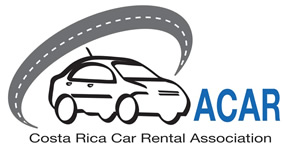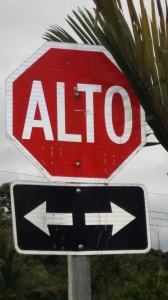What does it mean? Decoding the traffic signs in Costa Rica
Understanding Road Signs in Costa Rica
Signage in Costa Rica can be few and far between but it’s helpful to know some of the frequently used road signs to help you navigate your way around. Signs indicating distance are not always accurate, so support driving with maps and GPS system for confident navigation around the country. Here are a few of the most common signs on the roads:
| Spanish | English |
| ALTO* | STOP |
| CEDA EL PASO | YIELD |
| CALLE SIN SALIDA | DEAD END |
| NO ESTACIONAR | NO PARKING |
| NO ADELANTAR | NO OVERTAKING |
| NO VIRAR A LA DERECHA | NO RIGHT TURN |
| NO VIRAR A LA IZQUERDA | NO LEFT TURN |
| NO VIRAR EN U | NO U-TURN |
| UNA VIA | ONE WAY |
*Legally, the driver must bring the vehicle to a complete halt before pulling out at a stop sign and not just pause, but local drivers may not stop completely.
Parking Signs and street marking will indicate where parking isn’t permitted, or the times when parking is allowed – outside of peak hours. Street parking in cities and towns is often controlled by self-employed guards wearing bright orange vests who’ll accept payment to watch the vehicle during the owner’s absence. Alternately, find a secure parking lot and pay an hourly rate to leave the vehicle there. Restaurants, shopping malls and hotels will usually have a guard that patrols the parking lot. The guard will appreciate a tip for watching the vehicle. Regardless of where the vehicle is parked, ensure that all valuables are out of sight and better still, not left in the vehicle, and all windows and doors are closed and locked.
One way streets San Jose is a veritable maze of one way streets which can send the most experienced driver into confusion. Ensure that the car rental agency has given clear directions on traversing the city or better still, program a GPS system give clear directions to enter and exit the city center.
Warning signs:
Hazards are indicated in triangular warning signs. In the mountains, expect to see NIEBLA in areas that may be. Niebla means fog and is frequently seen on mountainous roads, such as Los Cerros de La Muerte and Route 32 through the Brauillo Carillo National Park. While fog isn’t common, it can be very thick and hamper visibility – slow down and use low beams. Driving at night is particularly unadvised through mountainous routes due to the increased risk of fog.
Derrambes means landslides, and drivers should be particularly alert if driving in rainy weather conditions on roads where these warning signs are erected. If weather conditions may increase the risk of landslides, local authorities will close roads with high risk, especially at night, as a preventative measure.
Sharp bends can be real sharp! If signage indicates that a sharp bend is being approached, slow down and even sound the horn in rural areas so that traffic from the other direction is aware of another vehicle approaching.
Steep inclines and declines will be indicated by signage. Going downhill, avoid riding the brakes which causes them to overheat and become ineffective.
Signs warning of animals crossing the road differ across the country, but stay alert to avoid squashing raccoons, sloths, or even frogs that may be using the highway.
Carretera en mal estado is an interesting sign to see as it means that the road is in a bad state of repair, but obviously it won’t be fixed soon as someone has decided that it will be bad for long enough to signpost it! Slow down instantly for this sign as potholes are inevitable. More recent damages to road surfaces may be shown by a branch stuck in the hole to alert road users to it!
Speed limit signs are clearly marked in kilometres. Do regularly check driving speed against the speedometer, as drivers used to North American and European roads may find these limits slower than in their home countries.
Changes in the speed limit can be signalled abruptly. Drivers should be alert to sudden decreases, and be prepared to slow accordingly. Traffic police often choose points where speed limits change to wait with speed recording equipment.
Stay alert for signs for schools and hospitals as speed limits are dramatically reduced to 15.5 mph near these institutions and similar.
Bridges outside of the cities are often one lane, so priority signs indicate which direction has the right of way. Obviously, if another vehicle is already on the bridge, then the other vehicle is obliged to wait regardless of right of way. There may be drivers nervous of reversing off a bridge so should you meet another vehicle in the middle of the bridge, be prepared to reverse back even if you’re in the right.
Narrow bridges are signposted with PUENTE ANGOSTO. They may not be one lane, but if the bridge is narrow, allowing traffic to pass before driving onto the bridge would be less hair-raising than trying to edge past an over-loaded cattle truck over a raging river!
Traffic lights follow the familiar pattern, although it’s worth knowing that failure to pull off at the instant the light turns to green will be punished by a chorus of honking horns.
Mostly, the signs are self-explanatory but with our guide to fill in the missing information, navigating Costa Rican roads should be a piece of cake!


Leave a Reply